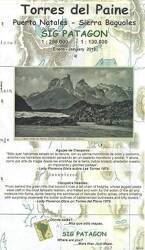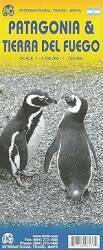
One More Day
Day Four — One More Day in the Park
I stayed five nights at a lodge in Cerro Castillo,
giving me four full days in
Parque Nacional Torres del Paine.
It's 60 kilometers from Puerto Natales to Cerro Castillo,
then another 60 kilometers from there to the park entrance.
I would advise anyone to do similar,
as the weather is unpredictable but tends toward
cloudy and wet with high winds.
My first and second days had some areas closed
due to sustained winds above 80 km/h.
My second and fourth days had less clouds
and even some direct sunlight.
On the fourth day,
I could see from the Y-150 road
after turning off Highway 9
that it was the clearest weather of my time so far.

The park is at the south end of the Southern Patagonian Ice Field, which extends 350 kilometers north to south, covers about 16,800 square kilometers, and feeds dozens of glaciers. Outside the polar regions, only the ice field in southeastern Alaska and northwestern British Columbia covers a larger area.
The large ice field is the source of powerful katabatic wind, from κατάβασις. The ice field chills the air above it. The cold air mass shrinks, gaining density and then flowing down from the elevated area in the form of strong winds.
Left to right in the below picture: Cuerno Paine Grande partly obscured by clouds, Cuernos del Paine in a dark shadow, Monte Almirante Nieto (the highest point visible here), the three towers of Torres del Paine Sur, Central, y Norte, and the broad face of Cerro Nido de Condor. This picture was taken with 3× zoom. Going from 1× to 3× or 10× on my phone switches from a 5.5mm lens to a 7.1mm lens and adds digital resampling.

The Y-150 road goes around the east end of Lago Sarmiento, which has a ring of calcium carbonate and magnesium carbonate deposits around its shoreline.
Hot water has risen from below ground, dissolving and carrying along some calcite from the underlying rocks. Those minerals are deposited along the shoreline as water evaporates. But there's more to it here.
Thrombolites have formed. Thrombolites form in shallow, salty, alkaline water when cyanobacteria, also known as blue-green algae, produce biofilms that bind sedimentary grains into oval or mushroom-shaped structures.
The Earth formed about 4.5 billion years ago. The earliest known life forms appeared possibly as early as 4.1 billion years ago. By 3.5 billion years ago, archaea and early bacteria were flourishing. The cyanobacteria lived where they could do photosynthesis through a shallow water layer. They formed biofilms that built up layer by layer into stromatolites, somewhat similar structures. Fossils of ancient stromatolites going back 3.5 billion years are found around the world, and coastal Western Australia is famous for modern-day stromatolites.
The thrombolites found here are much younger, going back only about 10,000 years. Humans were already living in the southern part of this continent and interacting with the giant sloth by 25,000 years ago.
So, the thrombolites are quite old in some sense, but not nearly as ancient as the stromatolites. And, instead of thin layers they contain clumps or clots, each a separate cyanobacterial colony on the scale of millimeters to centimeters in size.
The cyanobacteria perform photosynthesis through shallow water. Their photopigments absorb certain wavelengths of sunlight and split water molecules into hydrogen ions and oxygen. The hydrogen ions react with carbon dioxide to form carbohydrates, and the oxygen is released as a byproduct. Sediments and calcium carbonate stick to the biofilm they produce, with the overall thrombolite expanding outward less than a millimeter per year.
More on thethrombolites
The cyanobacteria do especially well in Lago Sarmiento because the water is very salty and it has a pH of 9. Not many organisms can live in that water. Snails won't be eating the biofilm as they would in typical lakes. And, the shallow water allow for photosynthesis.
This was my best classic view of the three towers — Torre del Paine Sur, Torre del Paine Central, and Torre del Paine Norte from left to right. The northeast slope of Monte Almirante Nieto is at left and the large face of Cerro Nido de Condor at right. This is with 10× zoom from about 30 kilometers away. Mid-morning of my fourth day was the only time I could see this iconic view.

I continued along Y-150 and then Y-156 to a viewpoint overlooking Lago Amarga. Now clouds had formed over the peaks, obscuring the three towers.

The peak of Monte Almirante Nieto at 2640 meters was visible.

I noticed an airliner contrail over the peaks. This was the first airline traffic I saw during my stay here, partly because of the clouds, especially to the northwest coming off the Southern Patagonian Ice Field, but also because there simply isn't much air traffic here. Puerto Natales and Punta Arenas are the only two airports south of here with scheduled passenger service. LATAM and Sky airlines connect them to Puerto Montt and Santiago.

The katabatic wind drives air around and over the peaks. Water condenses out into a cloud as the air rises and drops in both pressure and temperature, then returns to vapor form as the air drops beyond the peak.

It's the ideal gas law, pV = nRT. The pressure drop causes a corresponding drop in temperature. It passes the point where water no longer remains a transparent gas. What appears to be the upwind side of the cloud is the boundary where water vapor is condensing into a cloud.
| p | = | pressure |
| V | = | volume |
| n | = | number of moles of gas |
| R | = | constant to scale as needed for the units used for p and V |
| T | = | temperature in Kelvin |
The now-cloudy air moves over the mountain and its turbulence eddy, then it descends and the moisture re-vaporizes back into invisible suspension in the air at the downwind boundary of the cloud.
The result is a lenticular cloud which appears to stay in place as if the mountain is wearing a beret.

The clouds have noticeably moved within two minutes, 10:48:08 above, 10:49:56 below.

Then, just over one minute later, 10:51:02.

at Internet Archive
The Scottish war correspondant and author Lady Florence Dixie was the only female member of a party that traveled through Patagonia in 1878. Her 1880 book Across Patagonia includes an illustration of these three torres, which she called the "Cleopatra Needles".
I continued through Amarga into the park.

Continuing Into the Park
I returned to some of the vantage points I had visited in previous days. One of those was the Laguna Larga overlook with a nice view of Cuernos del Paine and Monte Almirante Nieto.



Zooming in, I could see blue ice high on Monte Almirante Nieto.


Clouds and lighting constantly change.

Areas in sunlight appear and change.

31 seconds later, from 11:33:48 to 11:34:19:

And then 42 seconds after that, 11:34:19 to 11:35:01:

I stayed one more night in Cerro Castillo. In the morning I bought ten liters of gasoline from my innkeeper, then headed down the End of the World Highway to Puerto Natales for two nights in that port town.



From θρόμβος or thrómbos meaning "clot" and λίθος or líthos meaning "stone". Related to the deep-vein thrombosis or blood clots you might develop on a long flight to Chile.